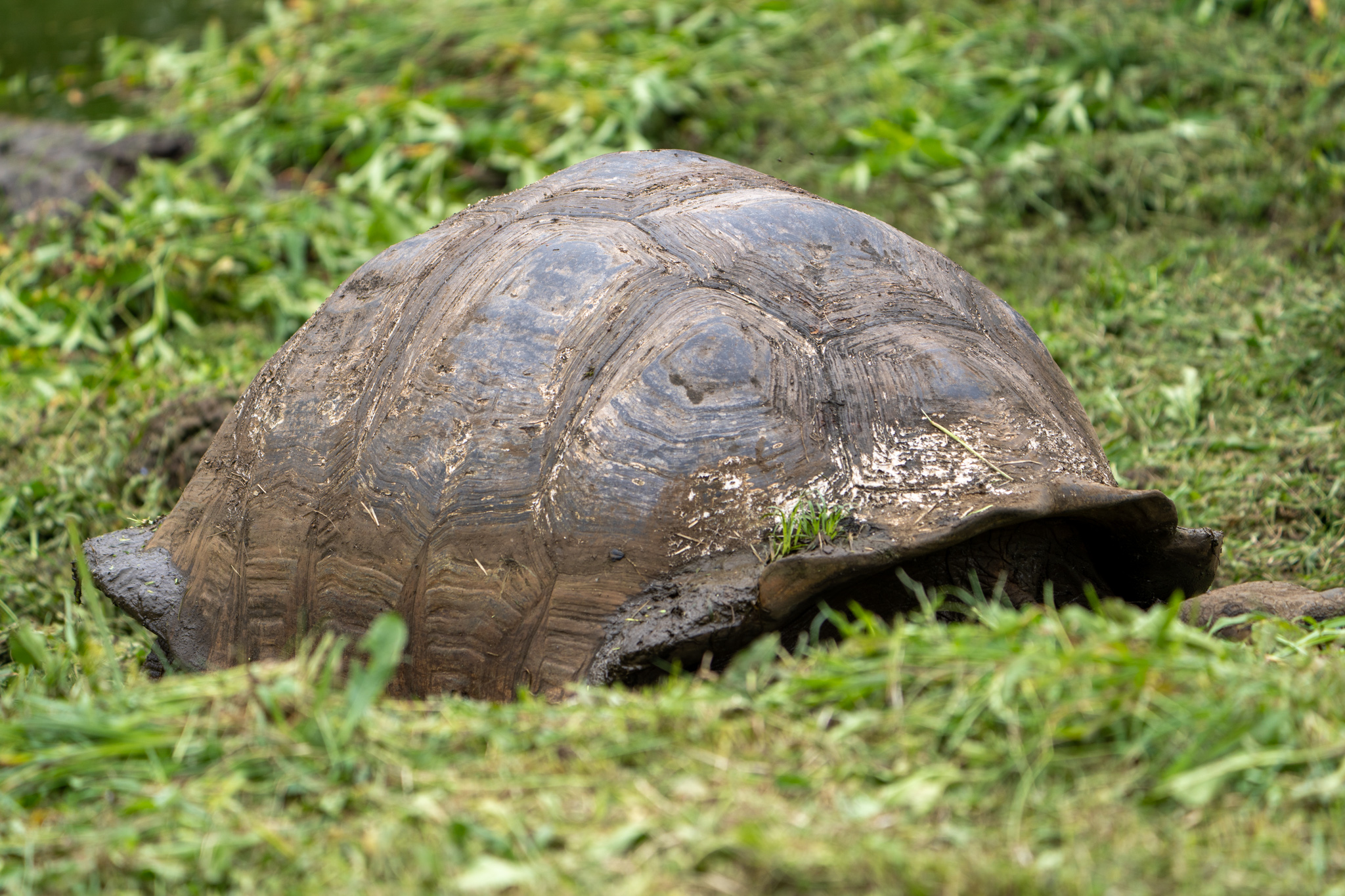Only 3.4% of the Galápagos archipelago is inhabited, only four of the 19 islands have permanent residents and only three have accommodation for visitors. Many islands, and parts of islands, are not accessible at all to tourists and are only visited by research scientists.
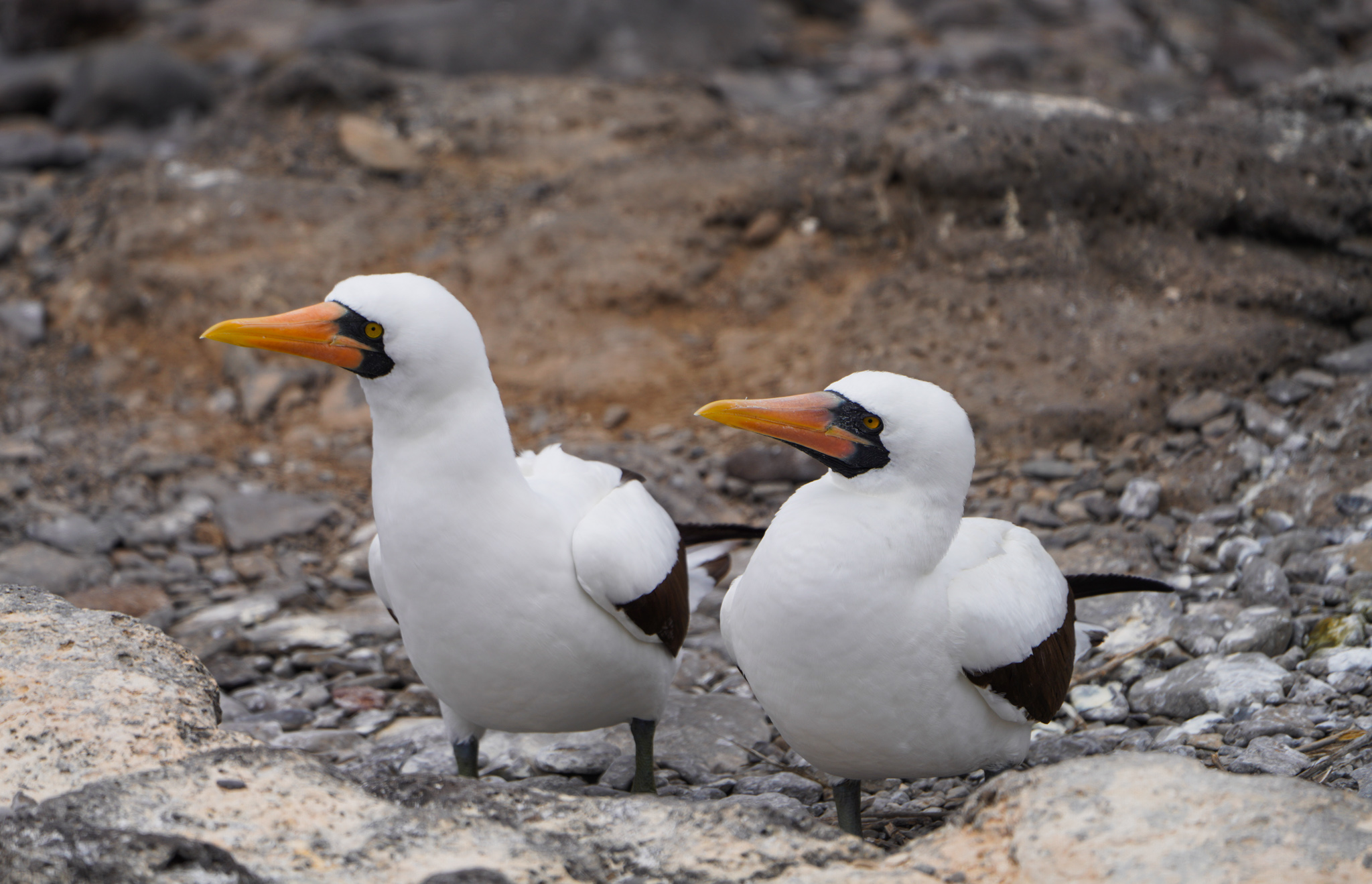
Two Nazca boobys on a part of Española island where tourists are permitted to visit
I was surprised and relieved to see how well tourism seems to be managed and restrained in this fragile place. There are strict limits on the number of boat licences available and how many tours can visit specified locations each day. The itineraries are set a year in advance and tour groups are kept small. Every visitor to a protected area must be accompanied by a guide, who themselves study for months to sit difficult exams in the hopes of being selected as one of the few Galápagos guides. They must know all about the geology, biology, marine biology and sociology of life on these islands. For this reason, every time we arrived at a location, our small tour group was the only one there. It truly feels as though the environment is being prioritised over the potential income that could be earnt. Perhaps that is also what makes the Galápagos such a special experience; despite its popularity it does not feel as though it has been overrun by tourism.
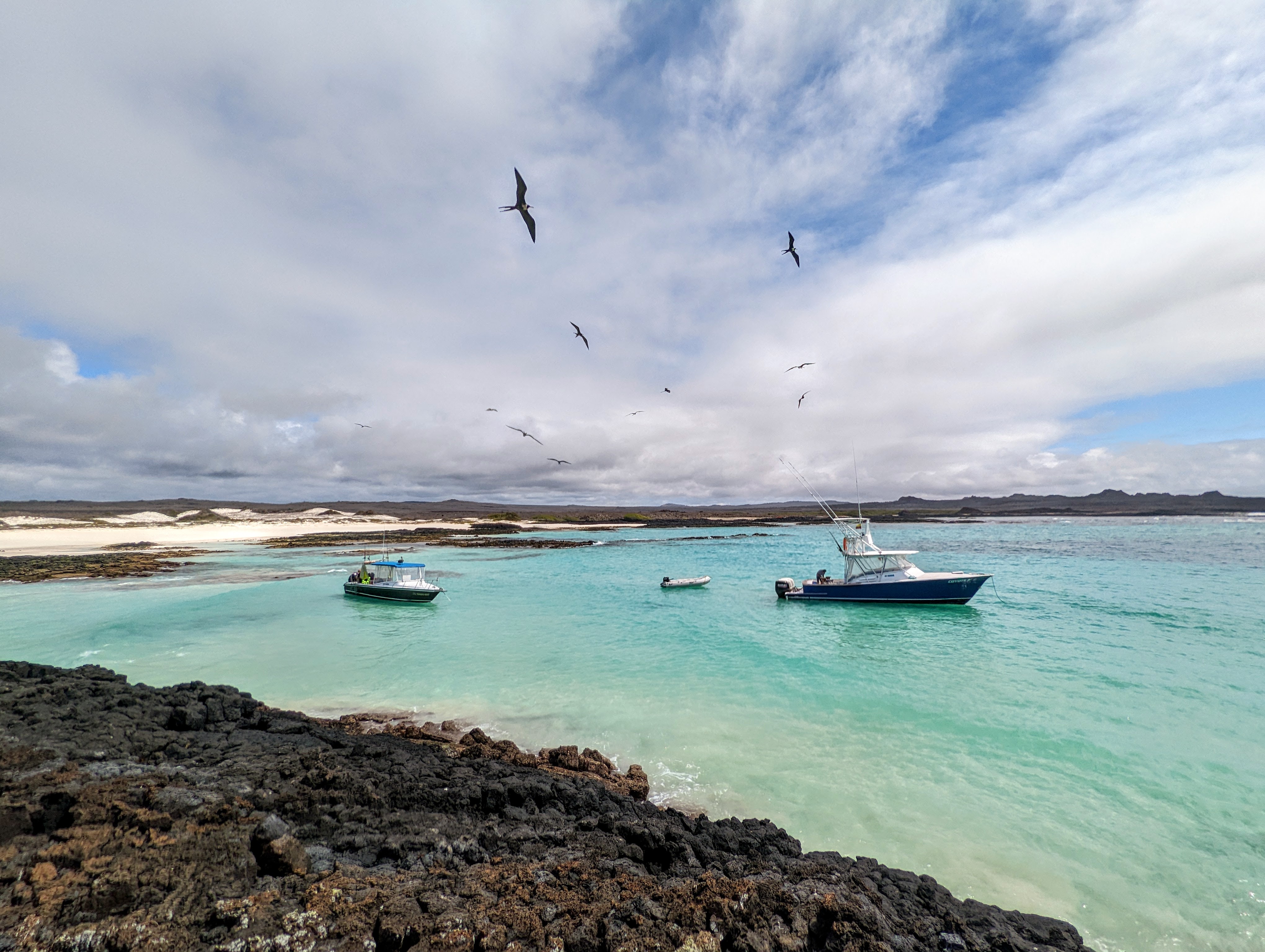
I was very pleased to arrive a little over two hours later at the San Cristóbal port, after having left Santa Cruz, swapping the rocking boat for stable ground. On arrival at the port, you are greeted by sea lions everywhere; lounging on the rocks, the benches, in the middle of the road, or wherever else they please.
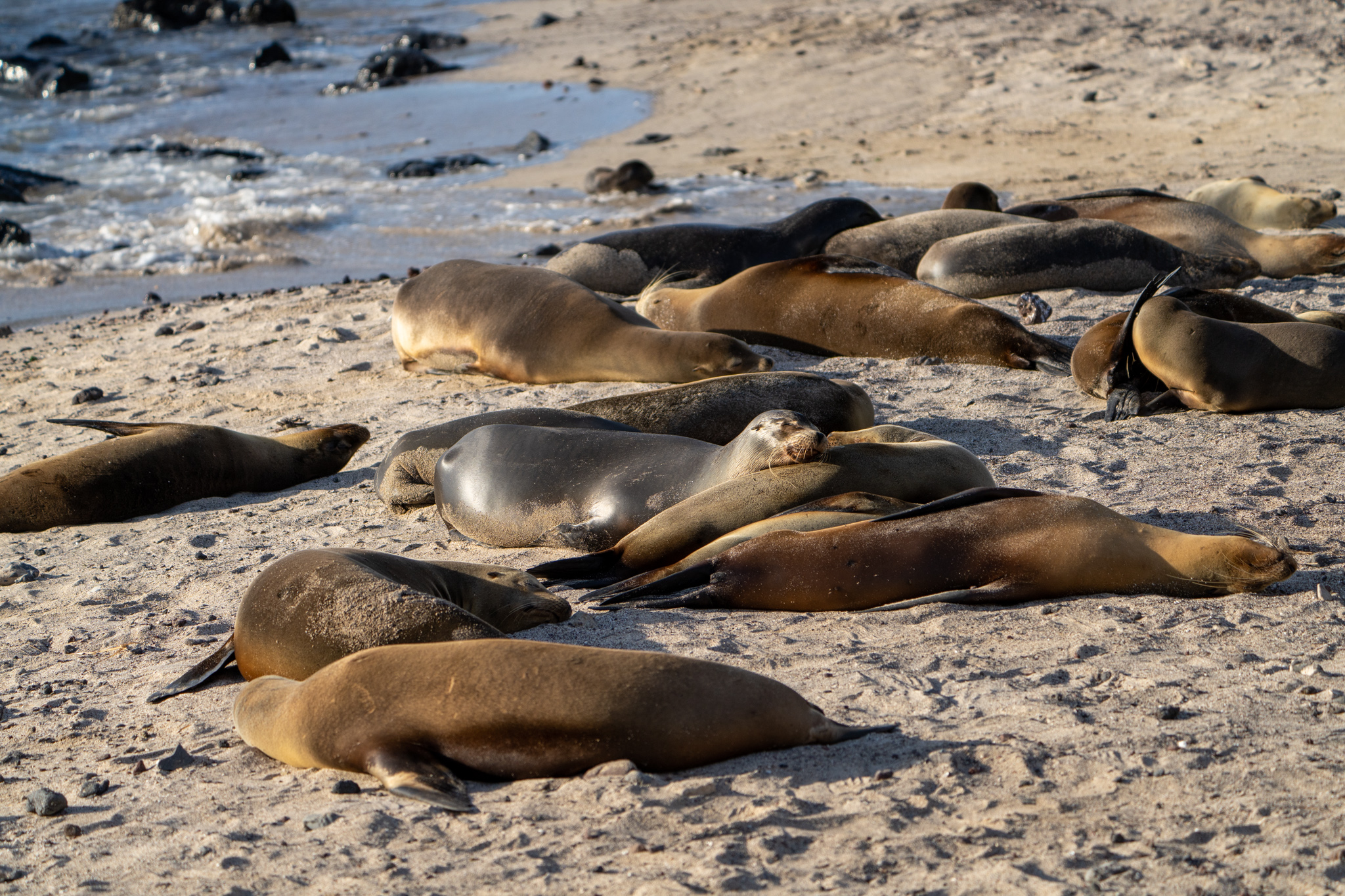
Sea lions crowding playa de oro
There’s a fenced off beach, playa de oro, at the end of town where a large group of them gather, the loud groans and snorts echoing across town. Many pups had recently been born and so there were a concophony of sounds of mothers calling and young pups trying to be heard.
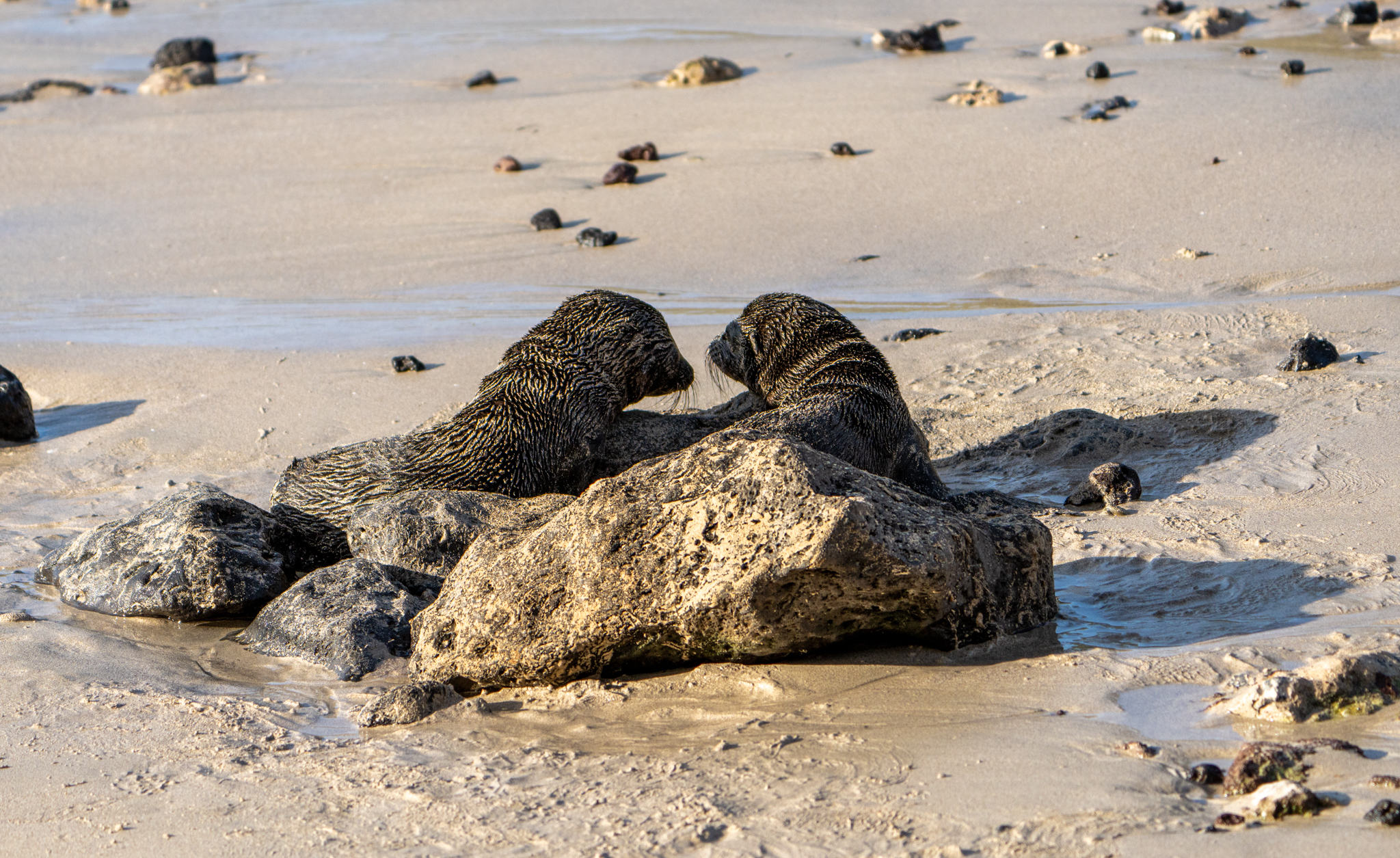
Two sand-covered pups playing at playa de oro
After dinner and a wander around town, we headed to bed before another early morning start. I was woken by the loud call of sea lions before the alarm, which sounds like someone puking after a big night out and so is not very pleasant.
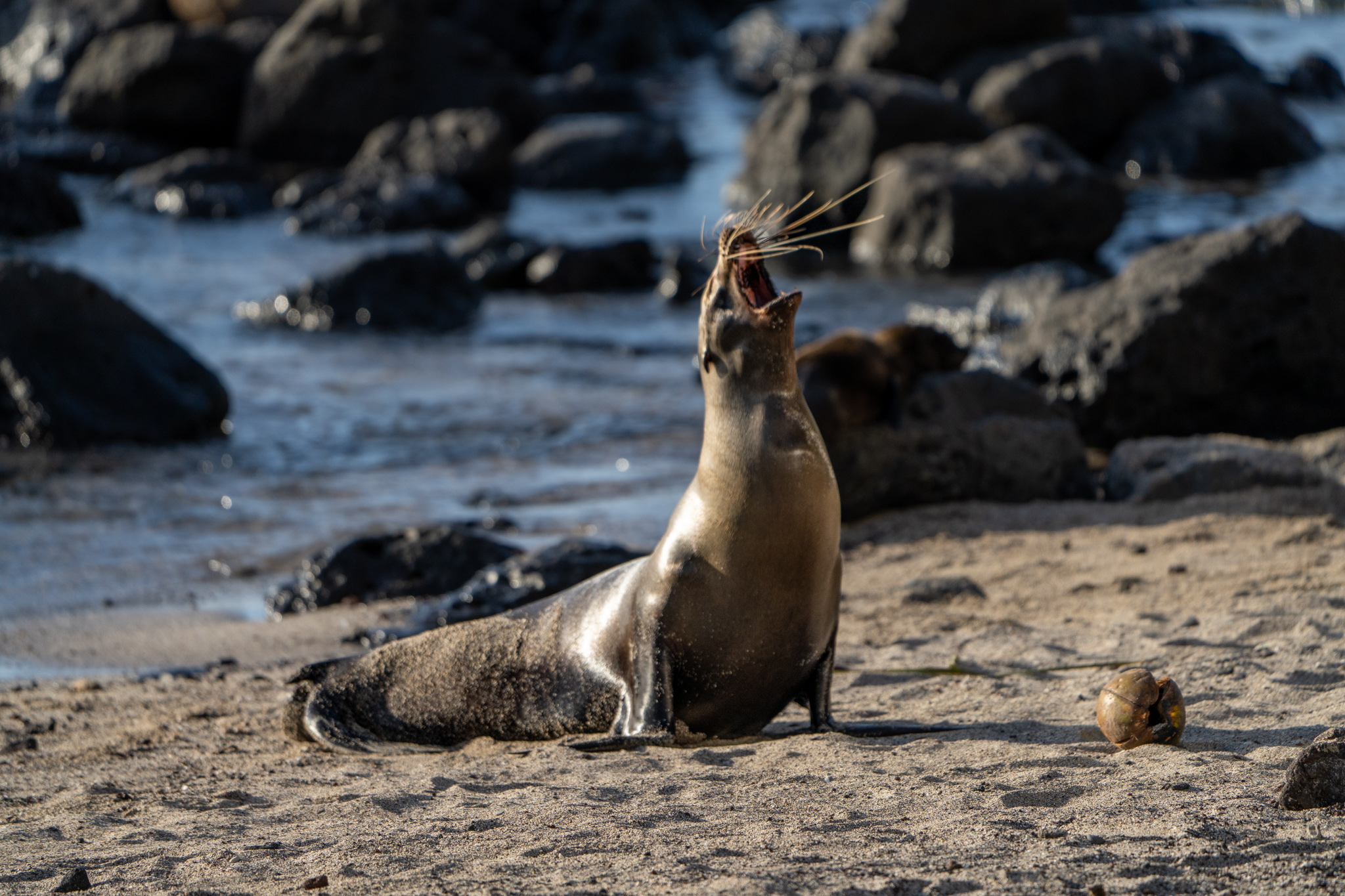
On this day we did the 360 tour, a boat ride that circumnavigates the island of San Cristóbal, stopping at different locations for snorkelling and swimming. It was our favourite day of our week in the Galápagos and an unforgettable experience.
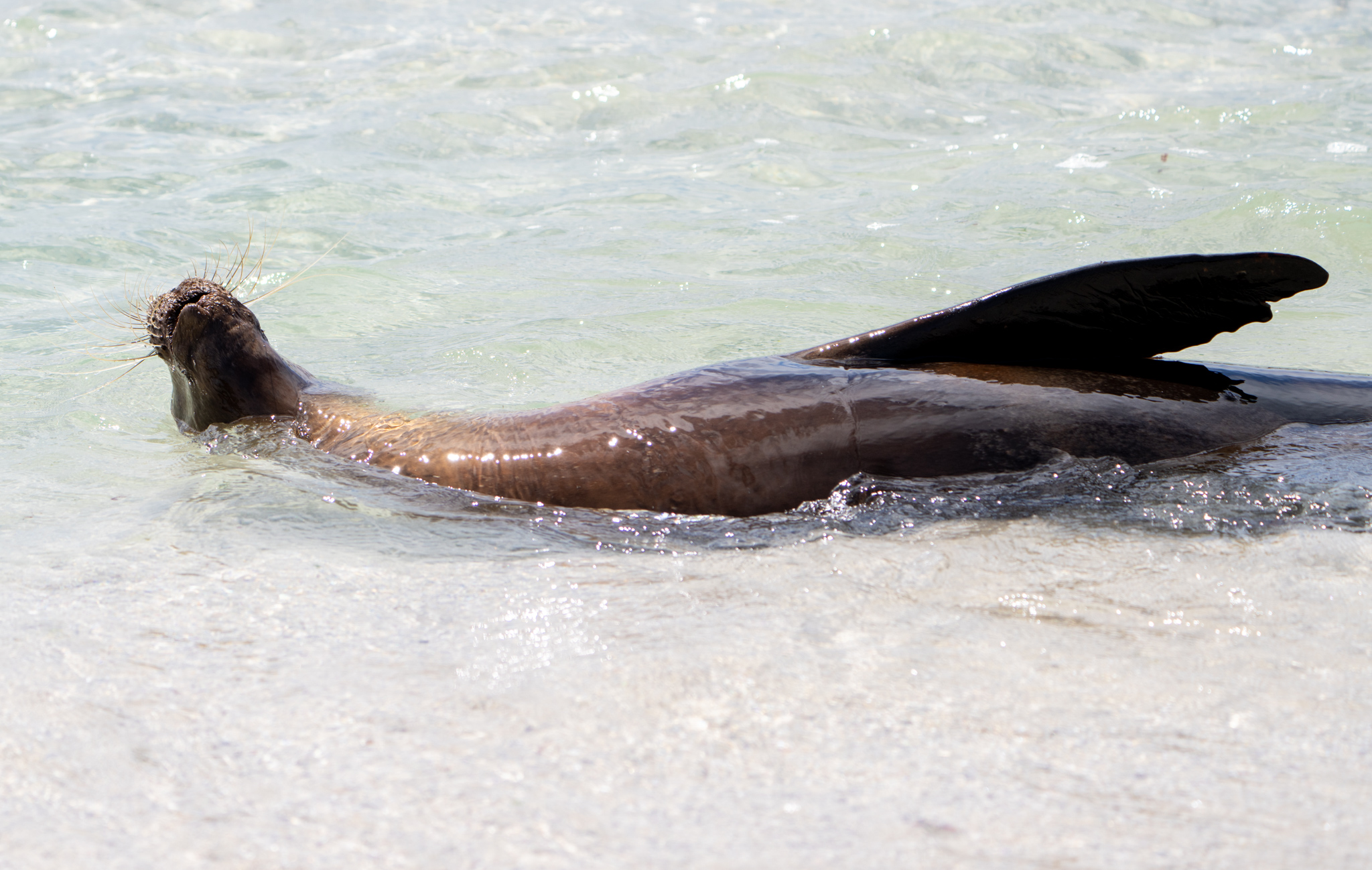
On the way to our first stop, we were following along the coastline, but then the driver took a sudden turn and headed away from land. At first we were confused, and then it dawned on us why he’d made a sudden turn; he’d spotted something in the distance offshore. A few minutes later, the boat slowed and we pulled up alongside two humpback whales, a mother and her calf. She put on a beautiful display for us, breaching out of the water and sending jets of water into the air from the blowhole.
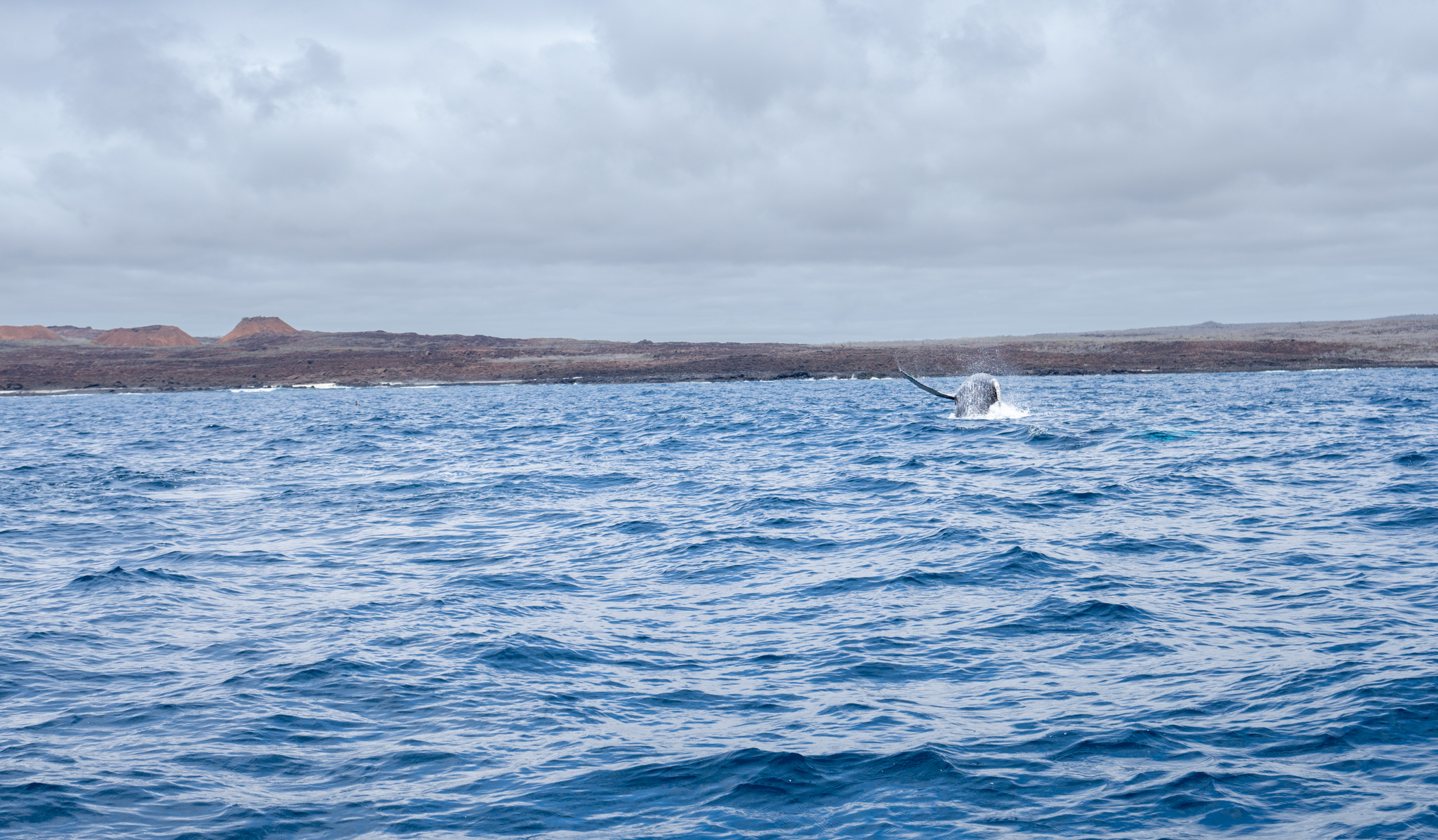
Whale spotting off San Cristóbal island
When they had moved on, we headed back towards the coast and landed at a small beach of squeeky, soft white sand and luminous blue water.
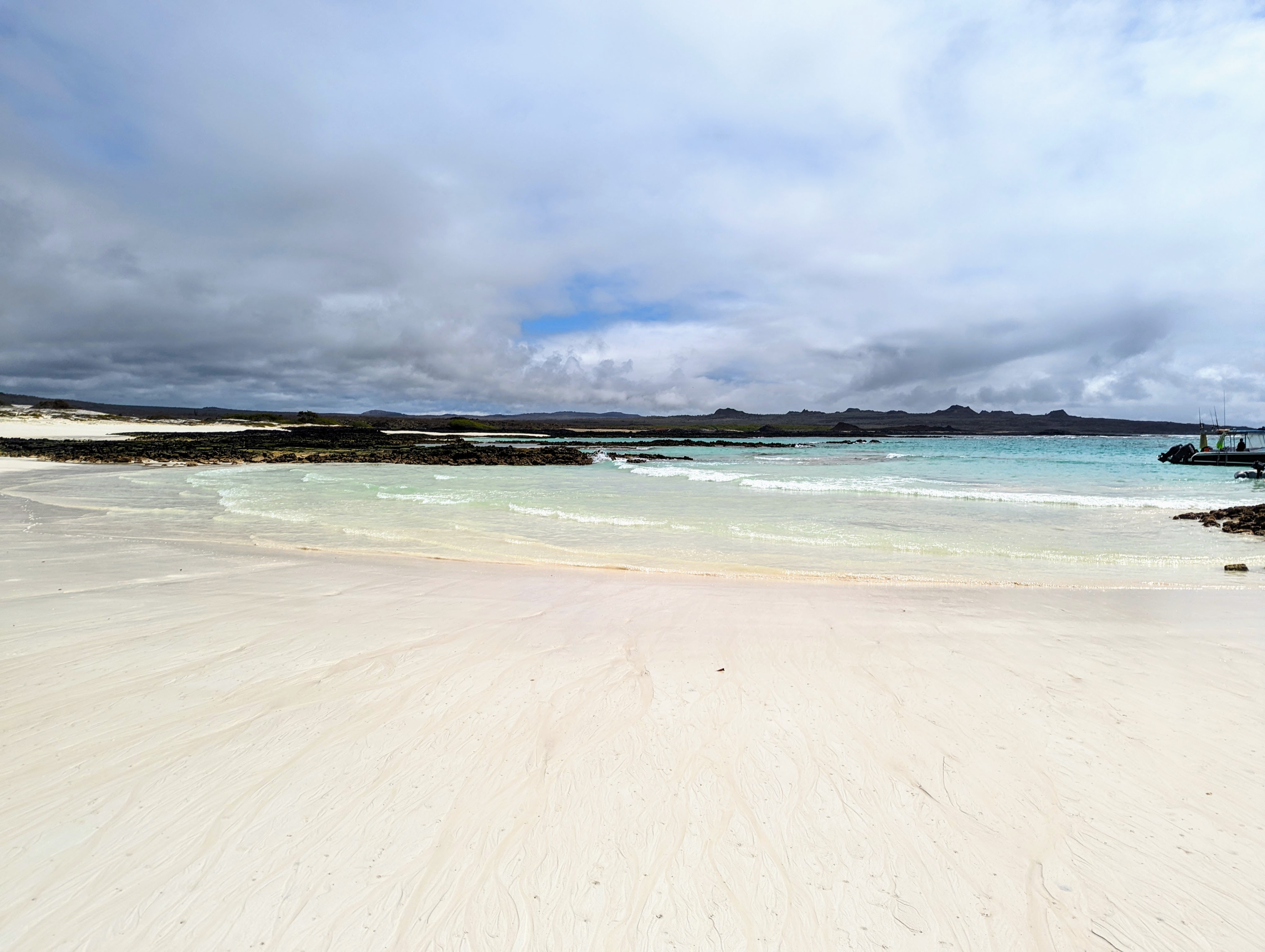
We were greeted by a curious little sea lion pup, who wandered among us, chewing at someone’s bag strap and then amusing itself at our feet with a tiny tuft of seaweed.
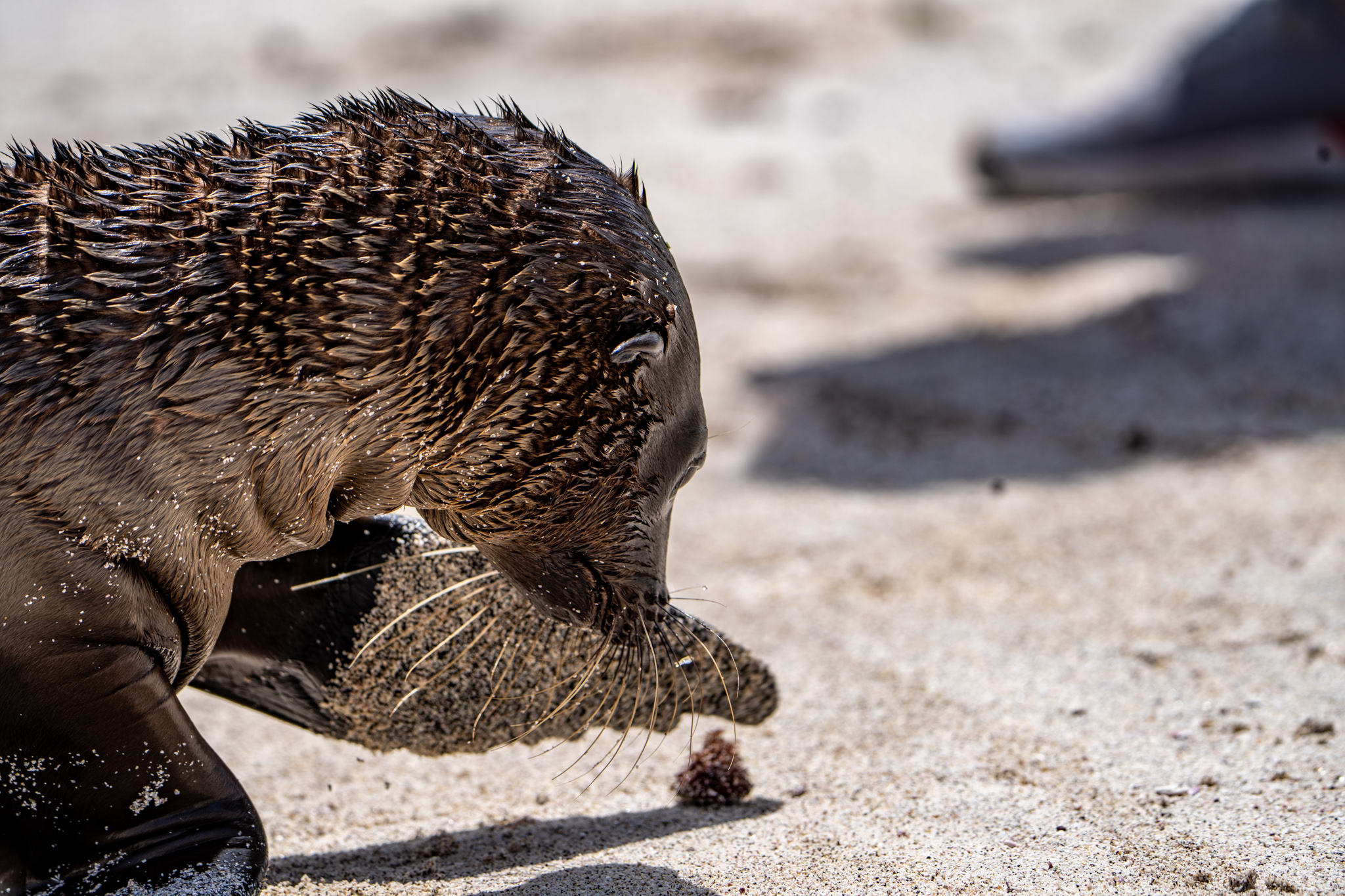
A sea lion pup playing with seaweed
We left the beach and headed inland, navigating carefully across the rocky terrain of lava rocks and cacti, walking for about 30 minutes until we arrived at a protected bay of dazzling turquoise water. We spent an hour snorkelling here, seeing the most spectacular marine life. There were puffer fish, star fish, eagle rays, spotted box fish and numerous sea turtles, who were completely unafraid, allowing us to swim right below or above them. They were breathtaking to watch, gently drifting through the water, scarcely coming to the surface for a breath.
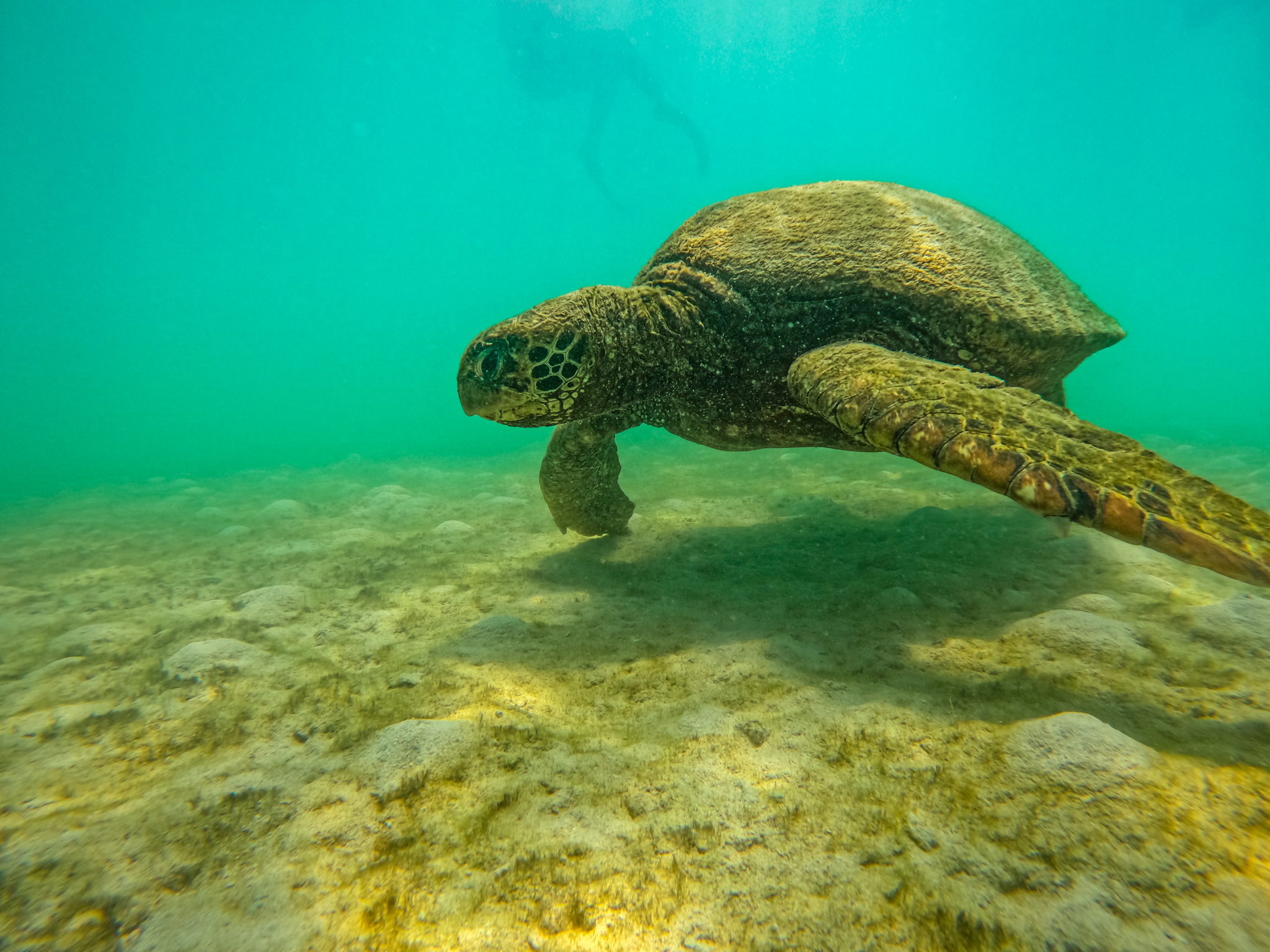
Swimming with the sea turtles
Afterwards, we had lunch on board our boat and a brief stop at a beach where we sat with sea lions on the sand and studied sea turtles lolling in the waves.
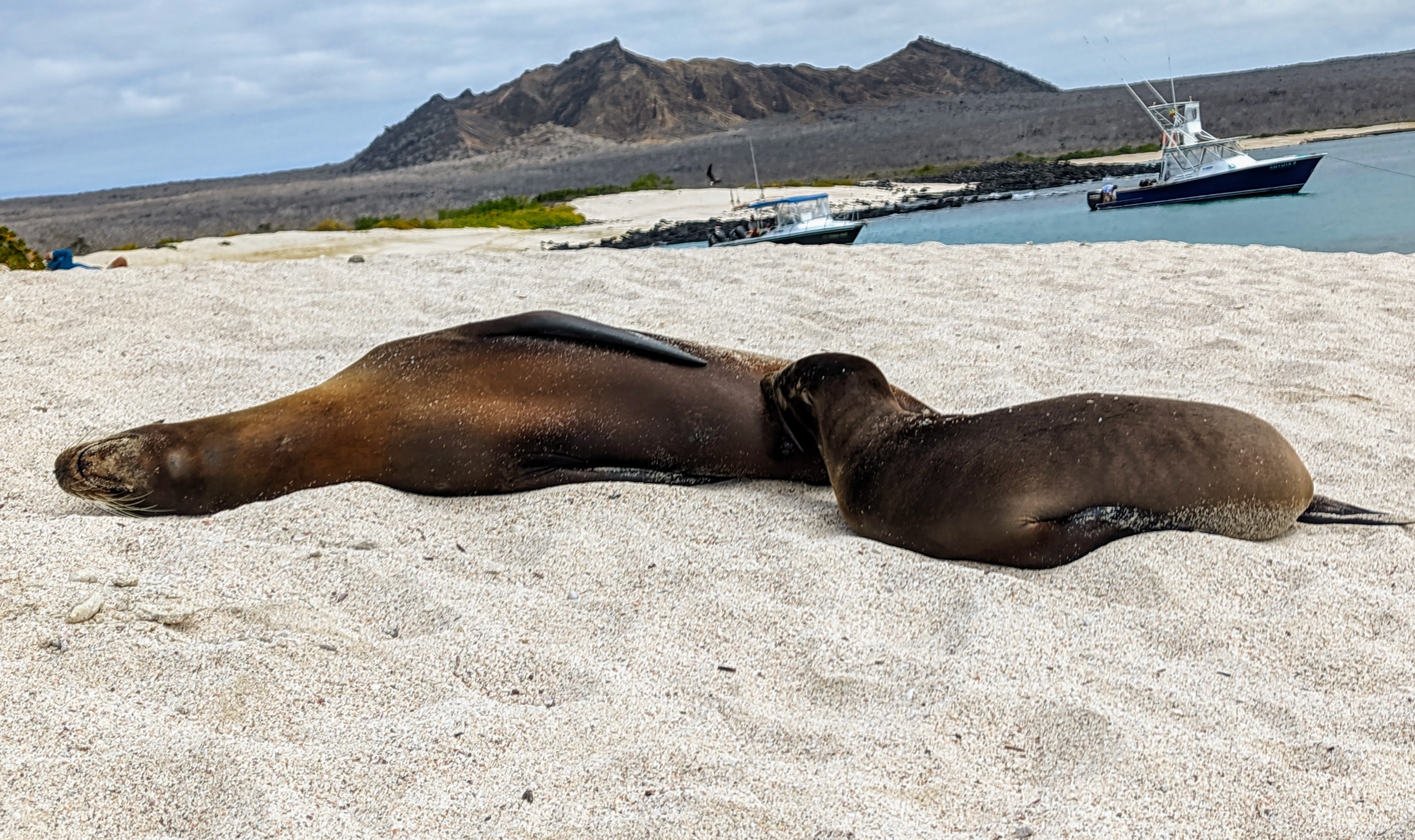
A young pup feeding with its mother
We then departed for Kicker Rock, the remains of a volcanic cone located further offshore, eroded by the ocean over many years. It has now formed two large rock formations with a narrow channel between them, which is perfect for diving or snorkelling with sea life.
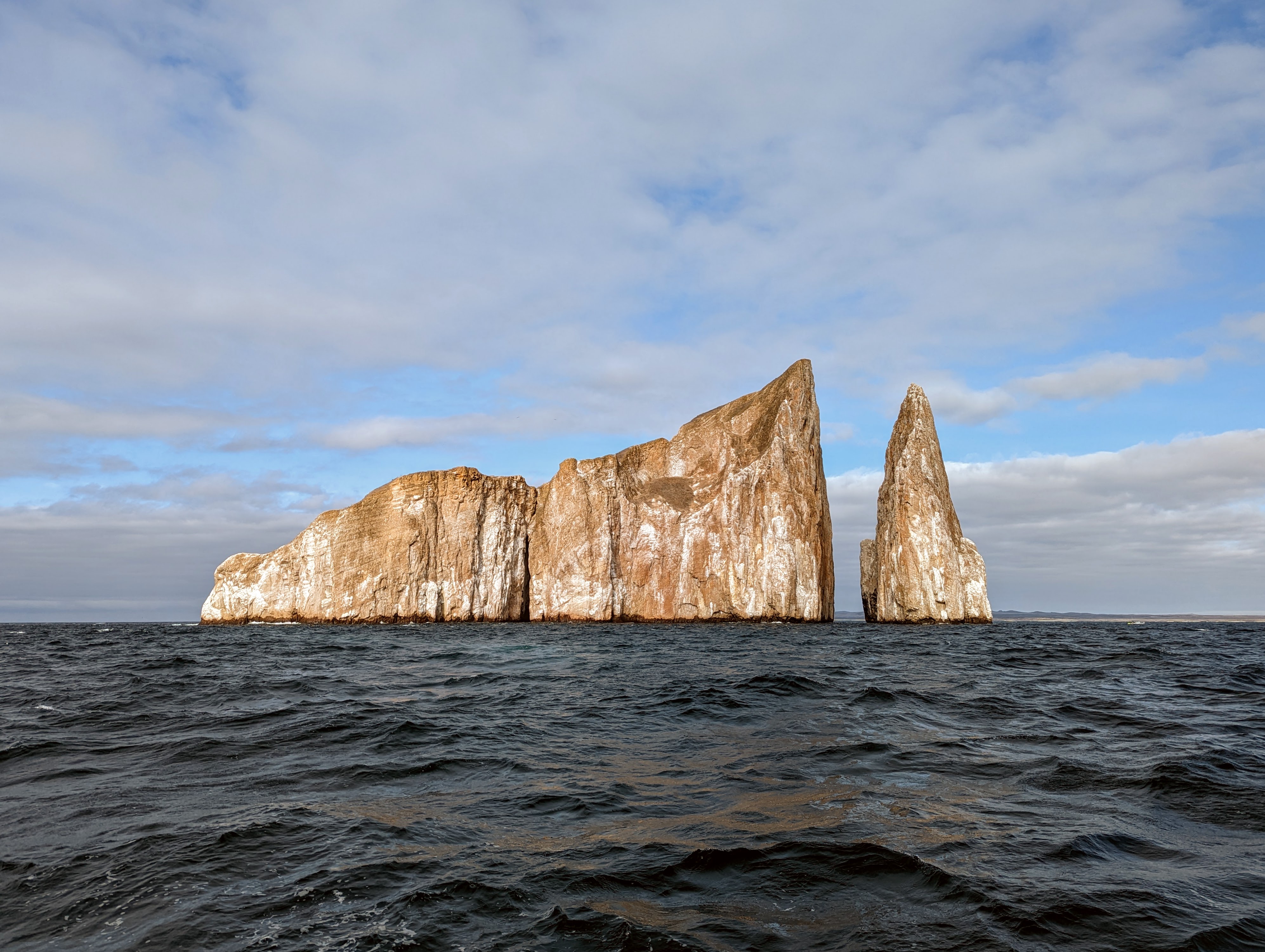
Kicker Rock
We arrived at Kicker Rock to a bit of a swell. I would have normally felt very nervous, getting into the deep open water, but we had to move quickly to get off the boat before it was swept into the rock and so without time to think about it, I jumped into the cold, rolling waves. It was a tough swim through the channel, being tossed around, trying to avoid the barnacle-covered rock walls. I could barely keep my head down to snorkel as the waves kept rolling over me sending water down into the snorkel, and so I swam head up through the channel instead, wondering whether the whole ordeal would be worth it.
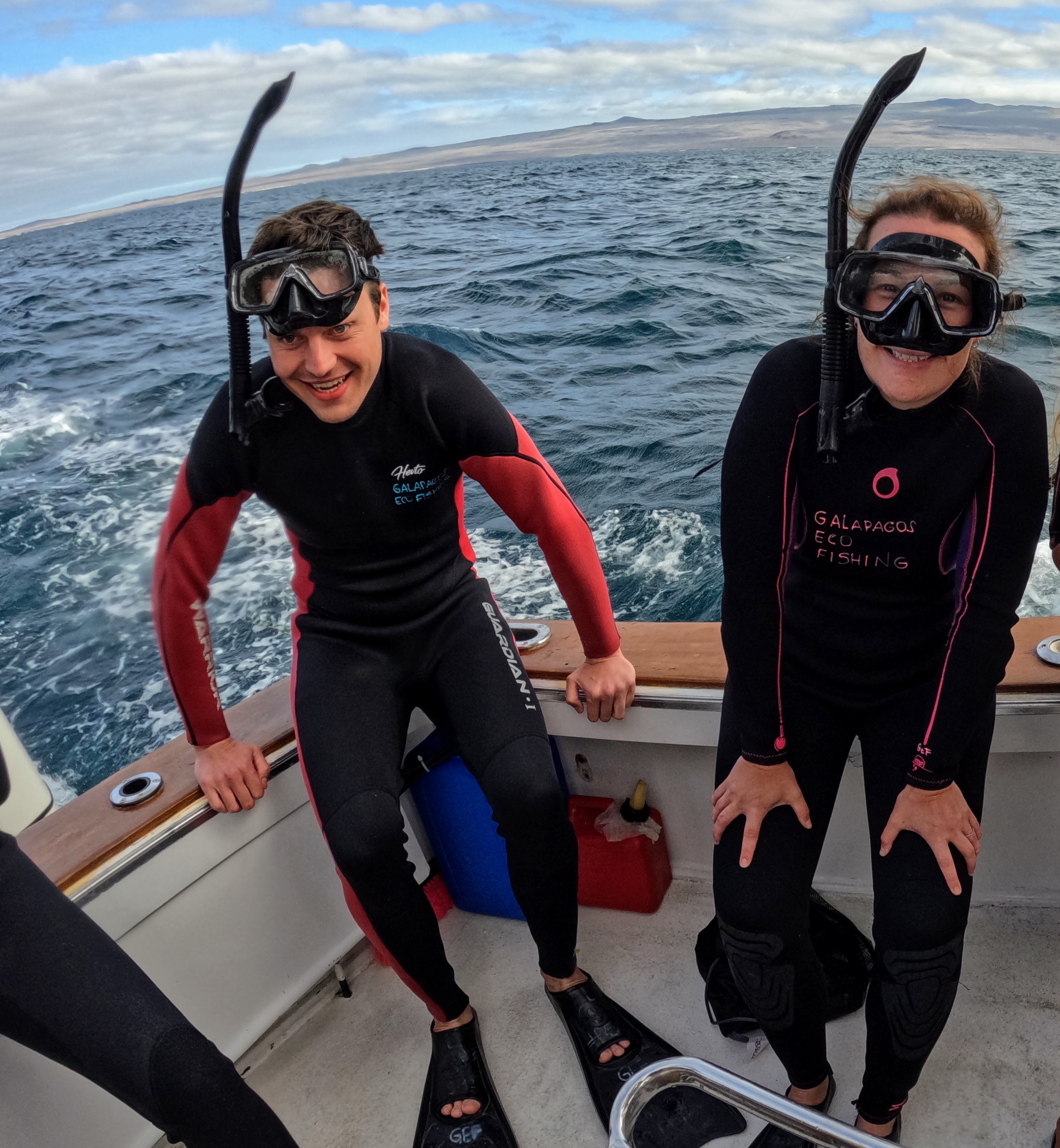
About to get in the water at Kicker Rock
As we emerged on the other side of the channel, the water calmed and so I brought myself to lay on the surface, peering into the depths below, seeing only a haze of cobalt. I turned to go the other way and as I rotated, a pair of eyes appeared, staring straight at me, barely a metre away. The sea lion somersaulted and, as if pleased with itself for catching me by surprise, swam in loops around me, skirting the edges of the rocks. Then there was another, and they were playing together, swimming in loops around our group and somersaulting over and around each other, sometimes briefly locking in an embrace. It was magical watching them play, with each other and with us, almost as though they were trained to deliver a paid performance.
We returned to the boat, changed into our dry clothes and then started the journey back to San Cristóbal.
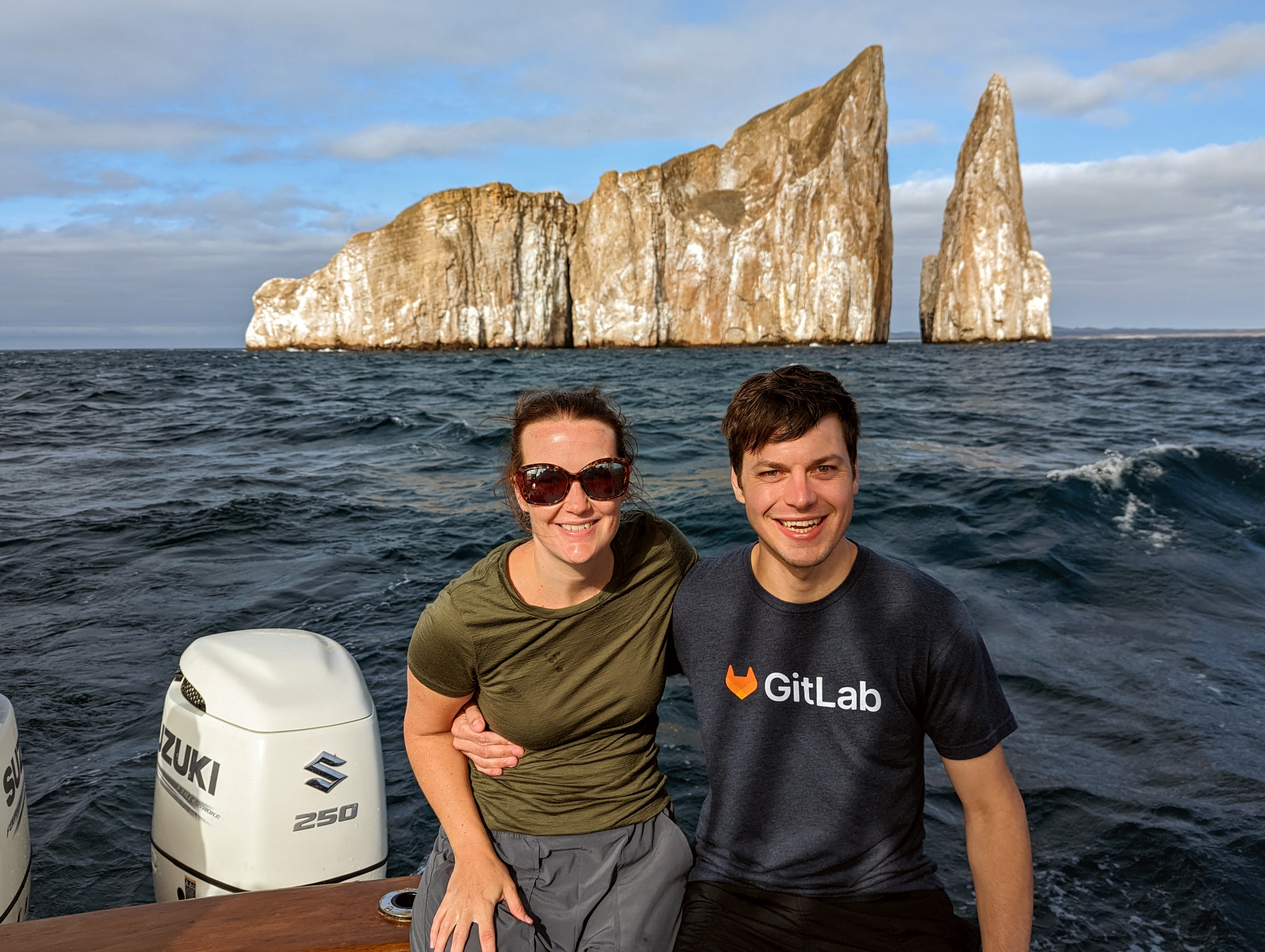
Leaving Kicker Rock behind
After a long day out on the water, we treated ourselves to dinner at the nicest restaurant on the island, Muyu, where we shared a starter of fish tartare made with the fish of the day caught that morning. For a main, I enjoyed roasted jackfruit for the first time and Dylan had lobster. There are restrictions on when lobster is allowed to be caught and so he took advantage its availability. It was then once more to bed before another early start and the final tour of the trip.
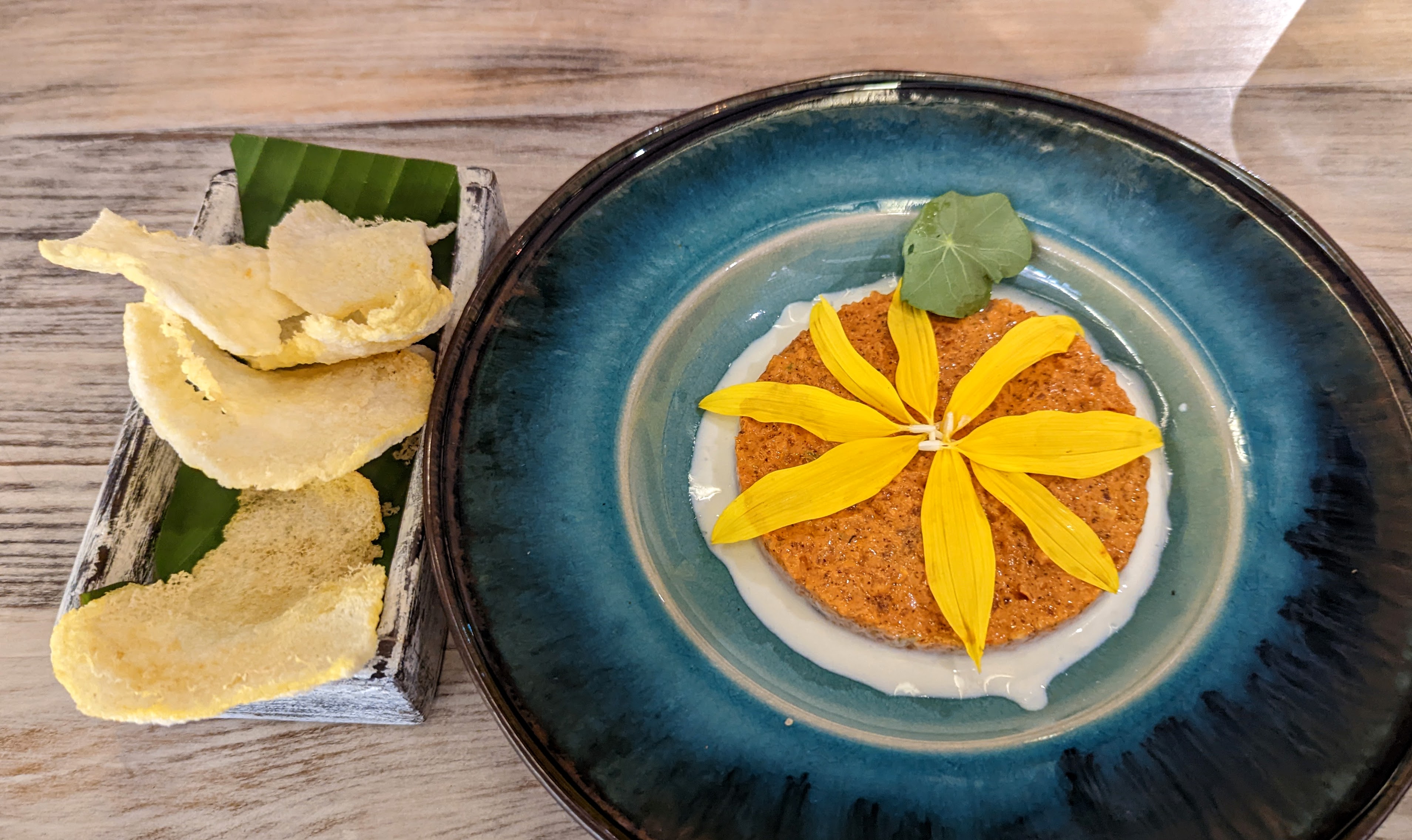
Fish tartare at Muyu
For our last day trip, we took a tour to Española island, which is not only the oldest island in the archipelago, but also one of the most genetically isolated. As a result, many of its animals are not only endemic to the Galápagos, but are also found exclusively on this island. This includes the largest marine bird in the tropical Pacific: the waved albatross. The main purpose of this day trip was to see the albatross.
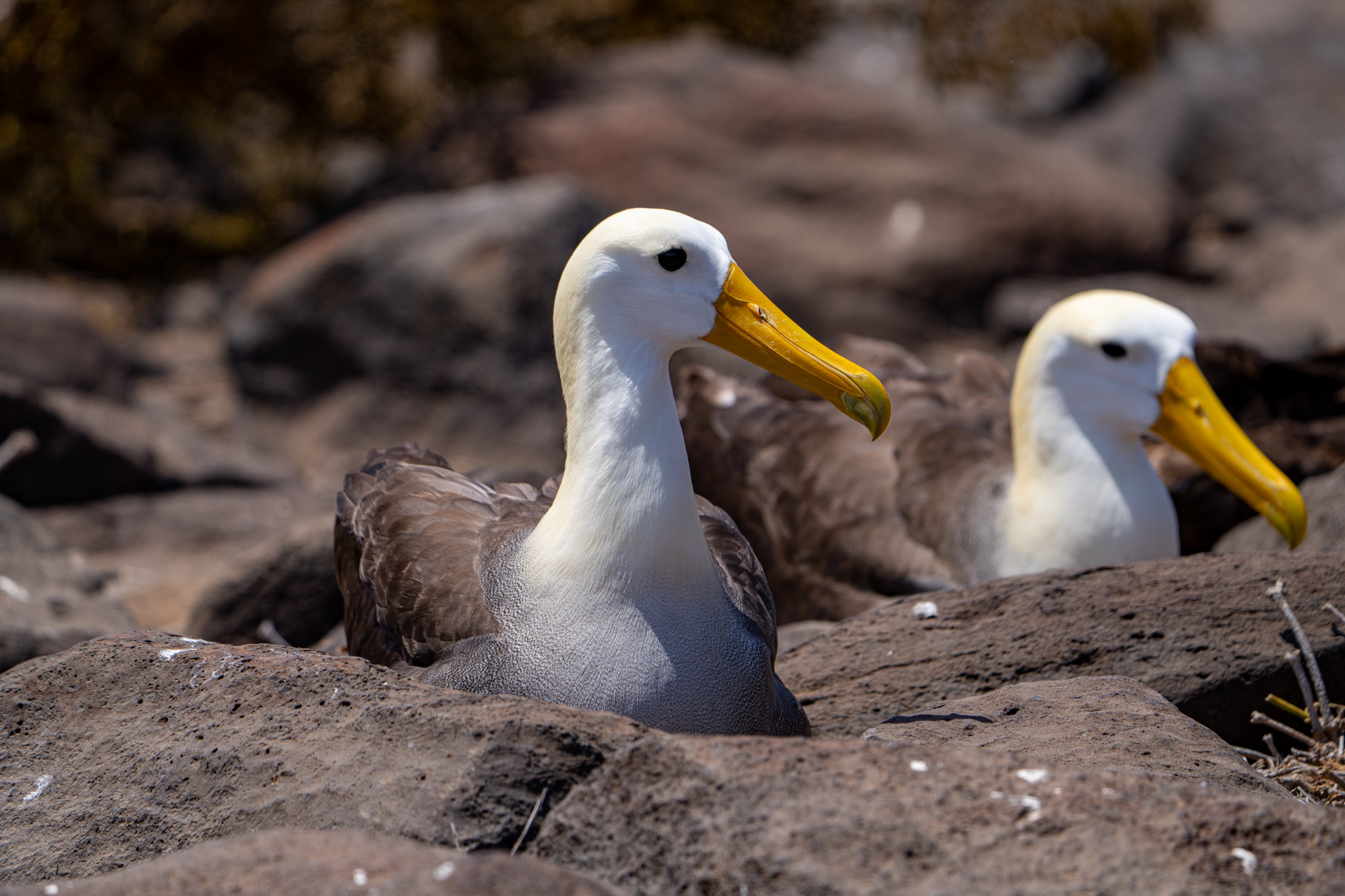
The waved albatross
Española lies on the south east corner of the archipelago, exposed to the Pacific Ocean without any protective barrier from other islands. To get to Española was a hair-raising two-hour boat ride across that exposed, open water. The driver navigated our small boat through the crashing waves, the boat slamming down off the crest of the waves, each time my stomach being momentarily left behind. With nothing to hold onto, I gripped Dylan’s arm with each rise and fall, staring determinedly at the stillest cloud I could find, the horizon nowhere to be seen behind the undulating swell.
And so it was a relief to finally reach Española island, going in small groups in a dinghy to get from our boat anchored offshore to land at an idyllic little beach. A pair of playful sea lions followed the dinghy in and then continued to play in the clear water lapping at the silicon shore.
After everyone had arrived at the little beach, we were led by our guide on a hike across the rocky, arid topography, the strong equatorial sun beating down on us in the exposed landscape. Along the way we saw lava lizards camouflaged on the lava rocks as well as Nazca boobys, another species of booby, named for their presence on the Nazca tectonic plate.
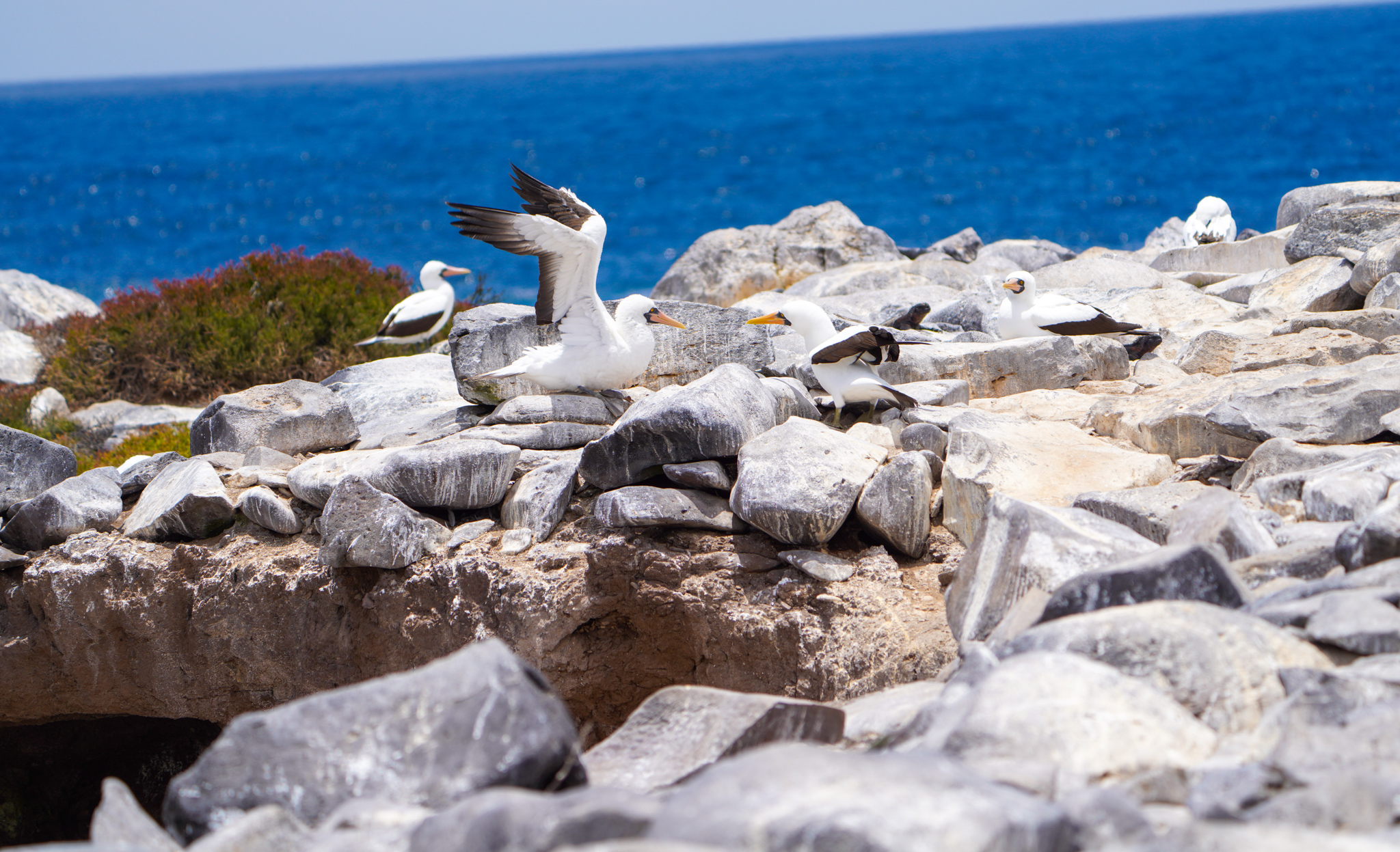
Nazca boobys
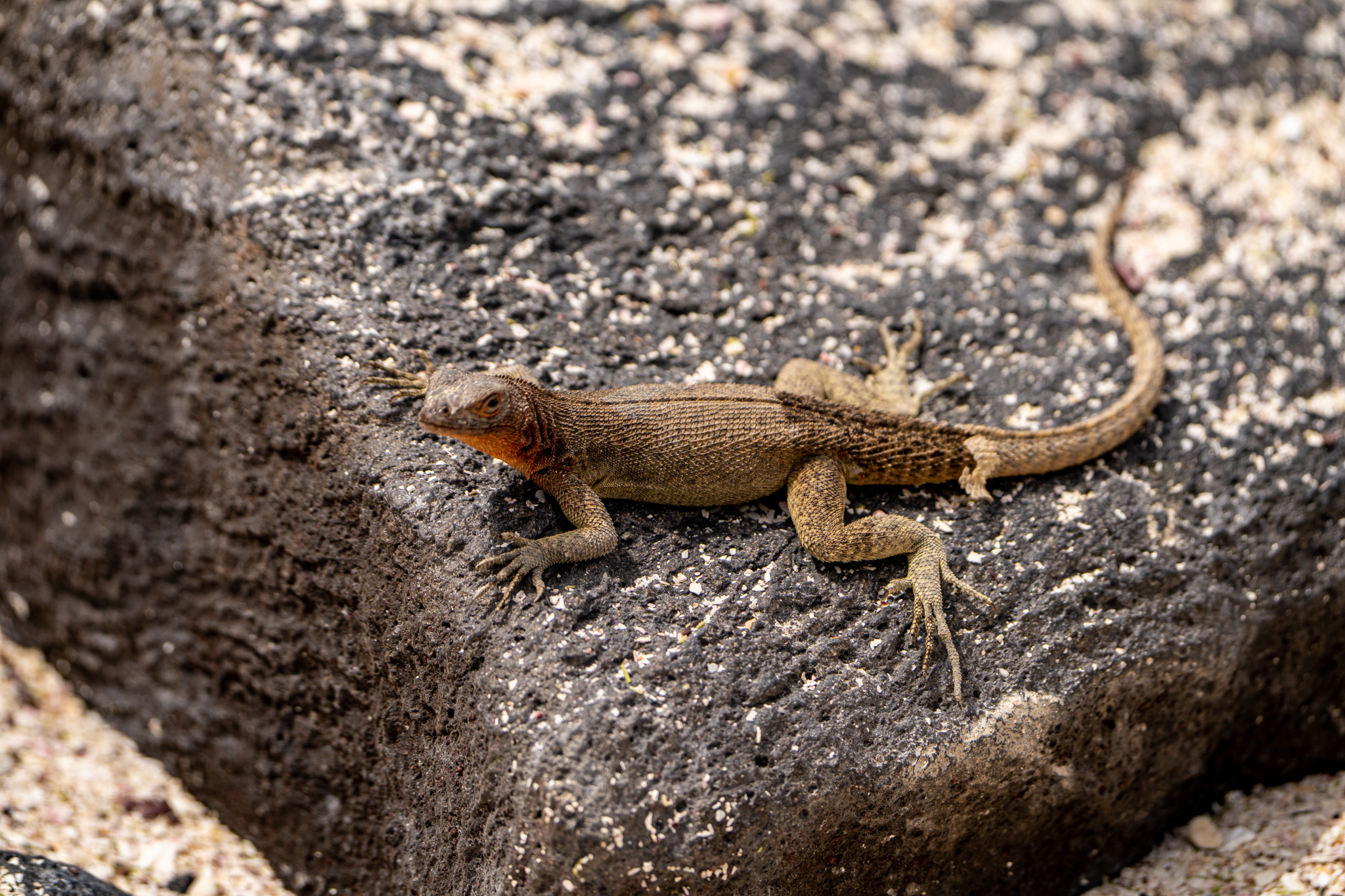
A little lava lizard
We were also lucky to spot the rarely seen Galápagos hawk. The Galápagos hawk is the apex predator in the Galápagos islands, but despite being the top land predator, it is under threat, with less than 500 individuals left.
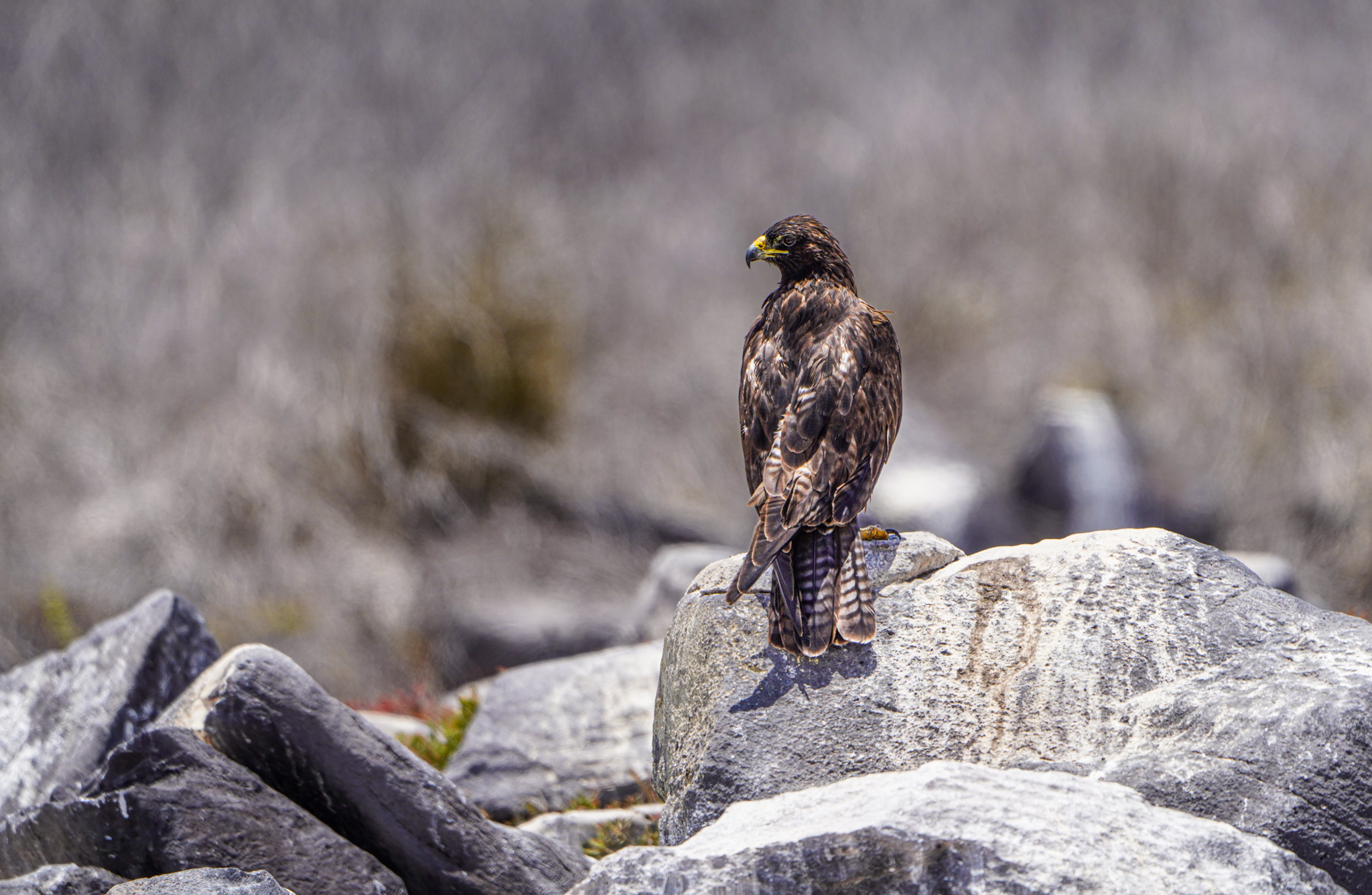
The Galápagos hawk
After walking for an hour or so we reached the albatross at their nesting site. We spent quite some time there, taking photos and admiring the fluffy baby albatross.
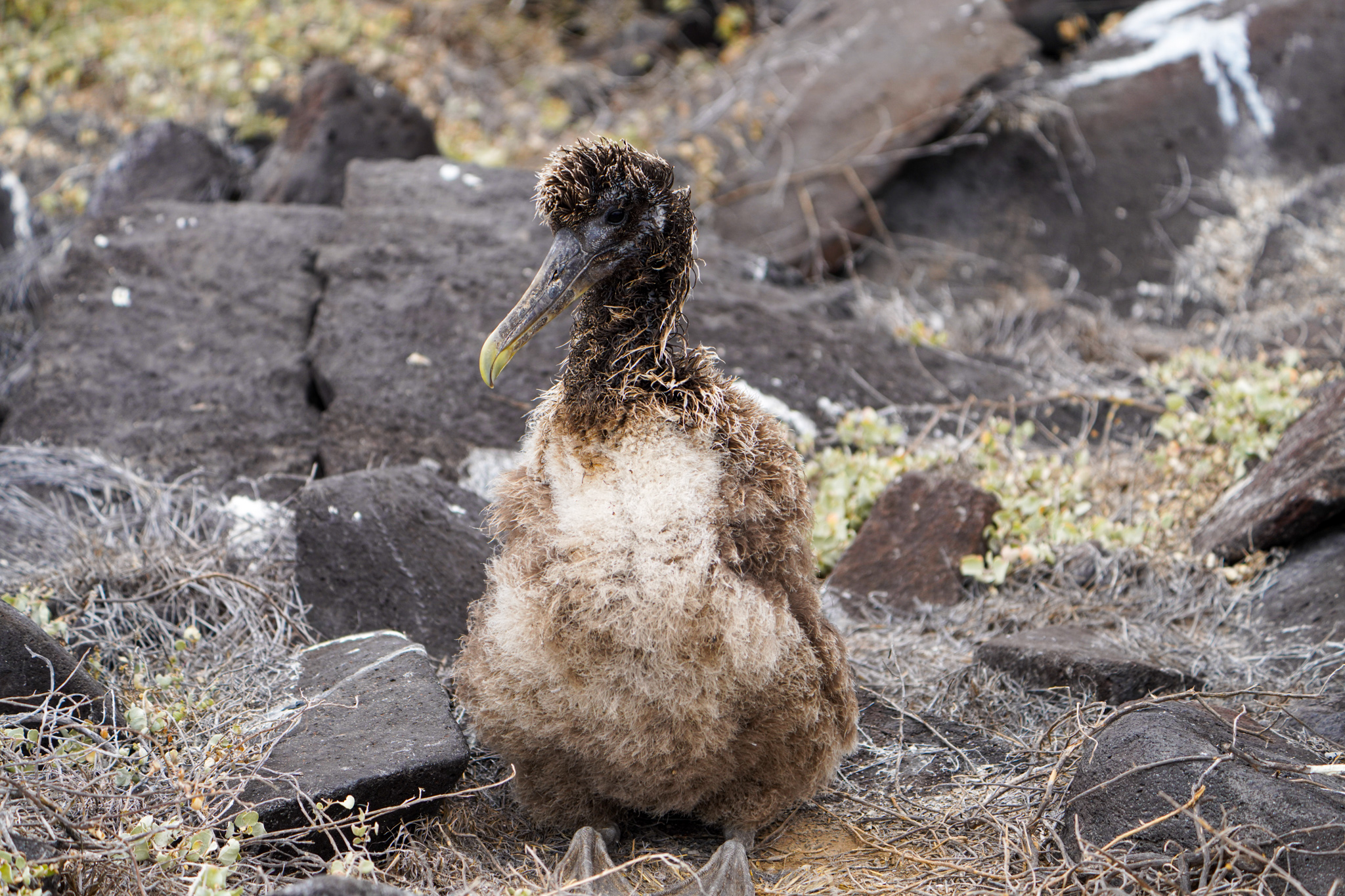
A baby waved albatross
But as we were about to leave, we were treated to a spectacular sight, more rare than anything else we had seen. Two adult albatross commenced their iconic mating dance.
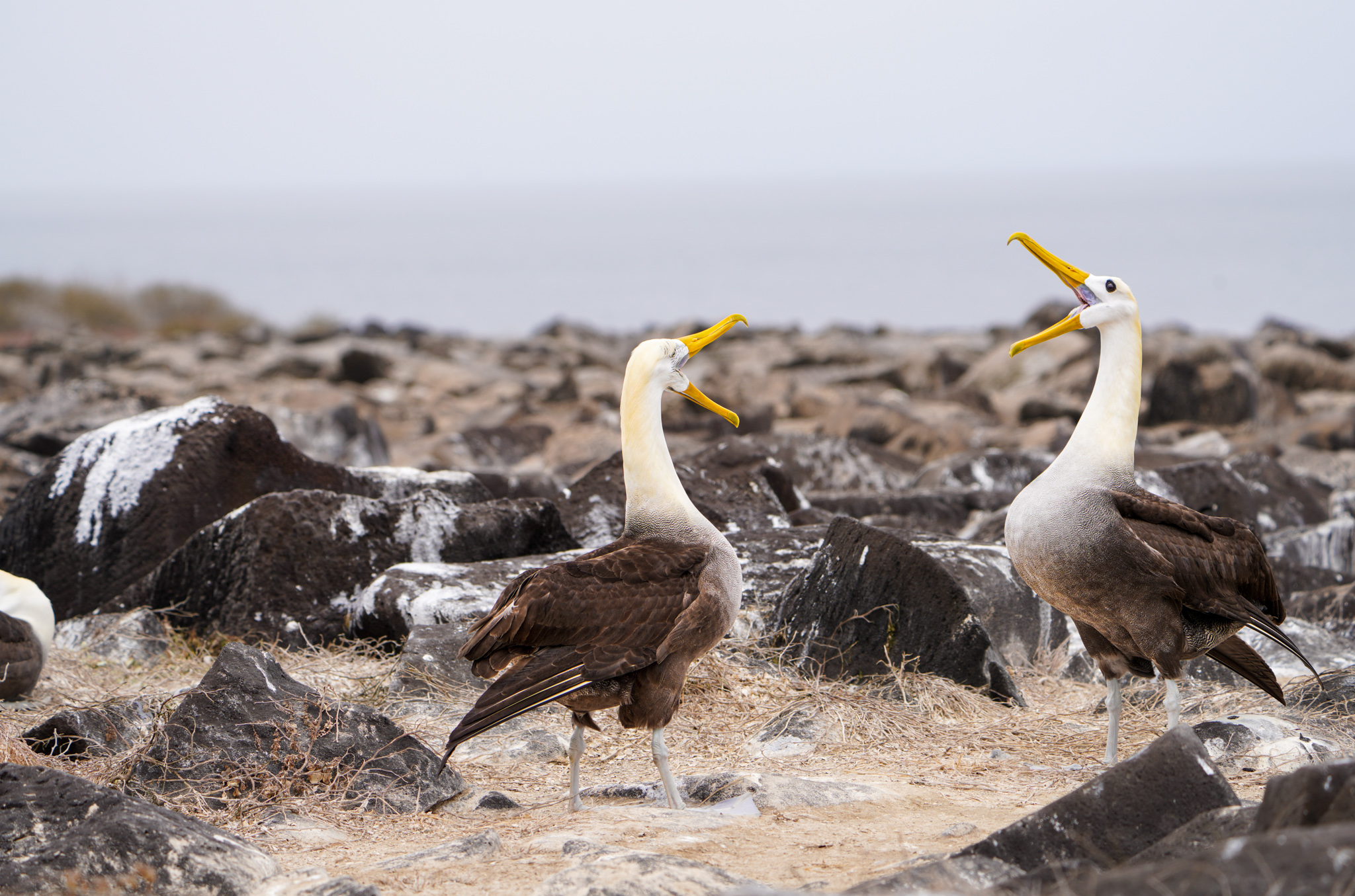
The waved albatross mating dance
It is a beautiful display of cooperative courtship, where the couple spend a prolonged period moving with each other, initiating and reacting with precision to the movements initiated or made by its partner.
We were extraordinarily lucky to see this because we shouldn’t have. Mating season had finished over a month ago, and even in the four years our guide had been visiting the island he had never seen the distinctive mating performance in person.
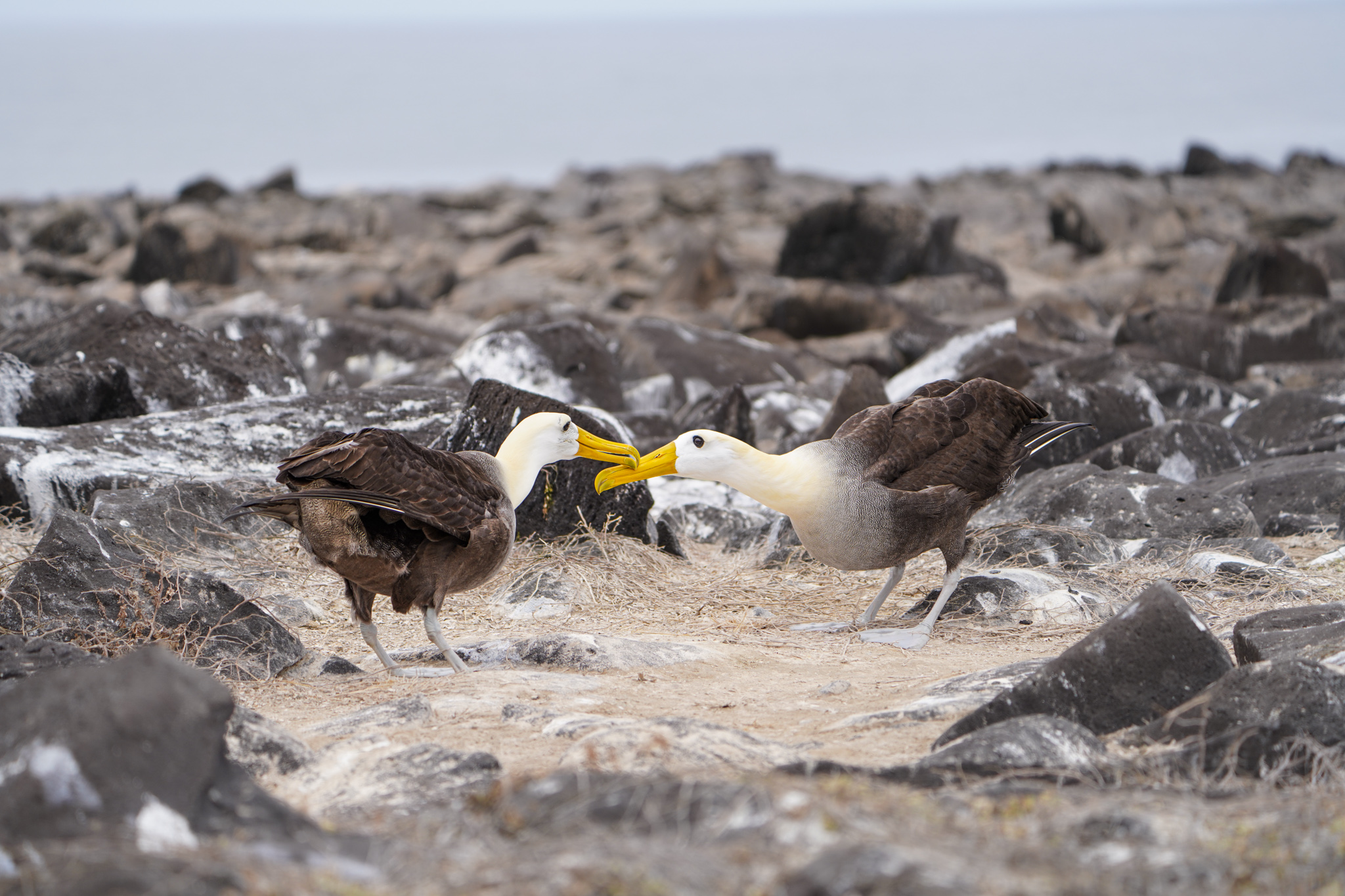
The waved albatross mating dance
It was an incredible experience. We sat there for a long time, no one wanting to take their eyes off the mirrored pair, but we had to move on and so very reluctantly, we left them to their amorous dance and made our way back to the boat for lunch.
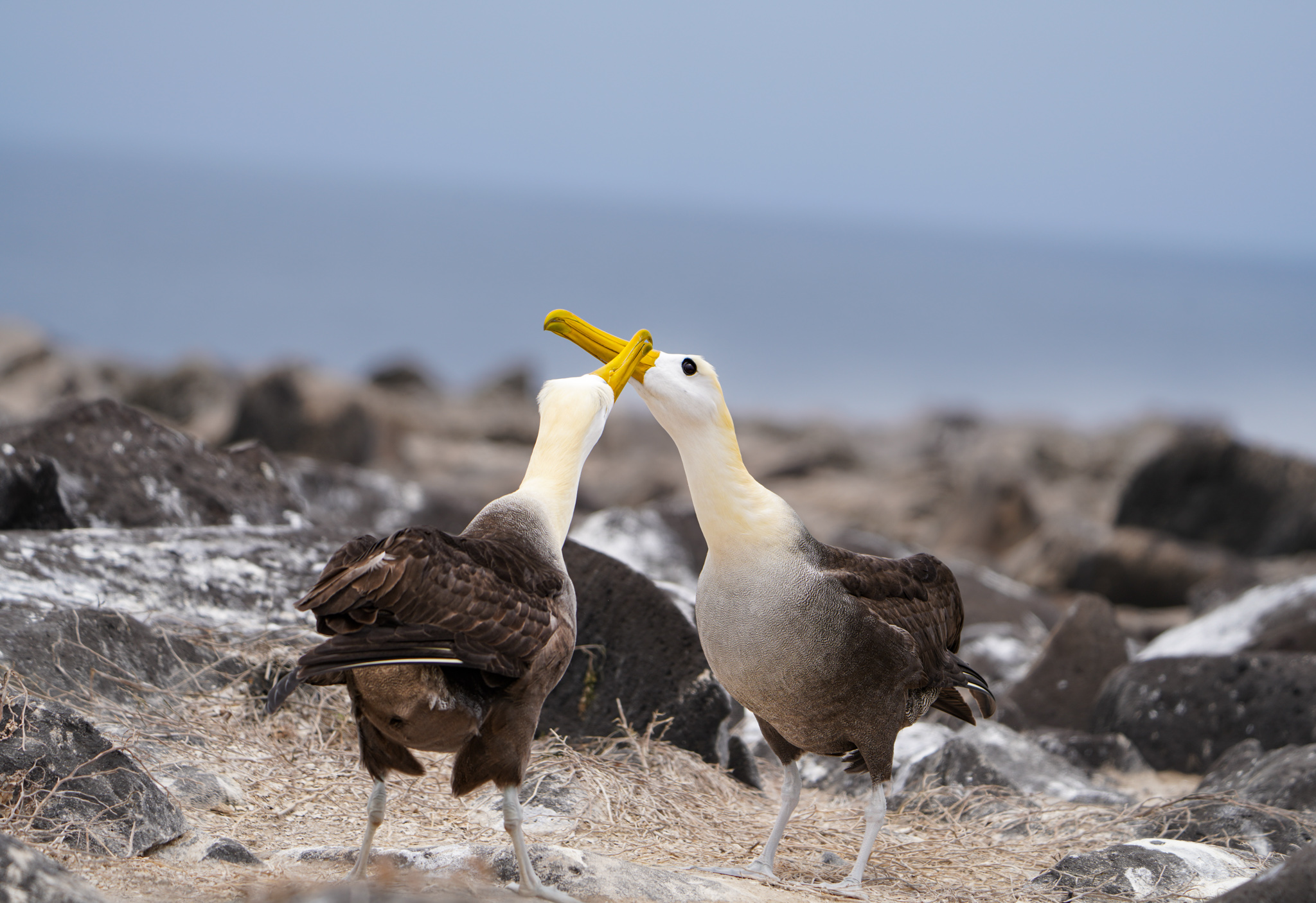
After lunch we went for another snorkel. Here the water was colder than any we had been in, perhaps any water I have ever swum in, and the scant 2mm wetsuit was doing nothing to stop the bitterly cold water from chilling me to my core. After only ten minutes in the water, I was shivering uncontrollably, unable to put my head under water. The lone sea turtle and few schools of fish weren’t enough to tempt the group for very long and so we got back on the boat, very grateful for the cup of hot tea handed to us by the crew.
Fortunately, the ride back to San Cristóbal was smooth and quicker than the ride over since the current was moving with us. Dylan and I had our last dinner in the Galápagos and then returned to the accommodation to pack our bags for our departure back to Quito the following morning, watching the sun setting over the bay below as we packed.
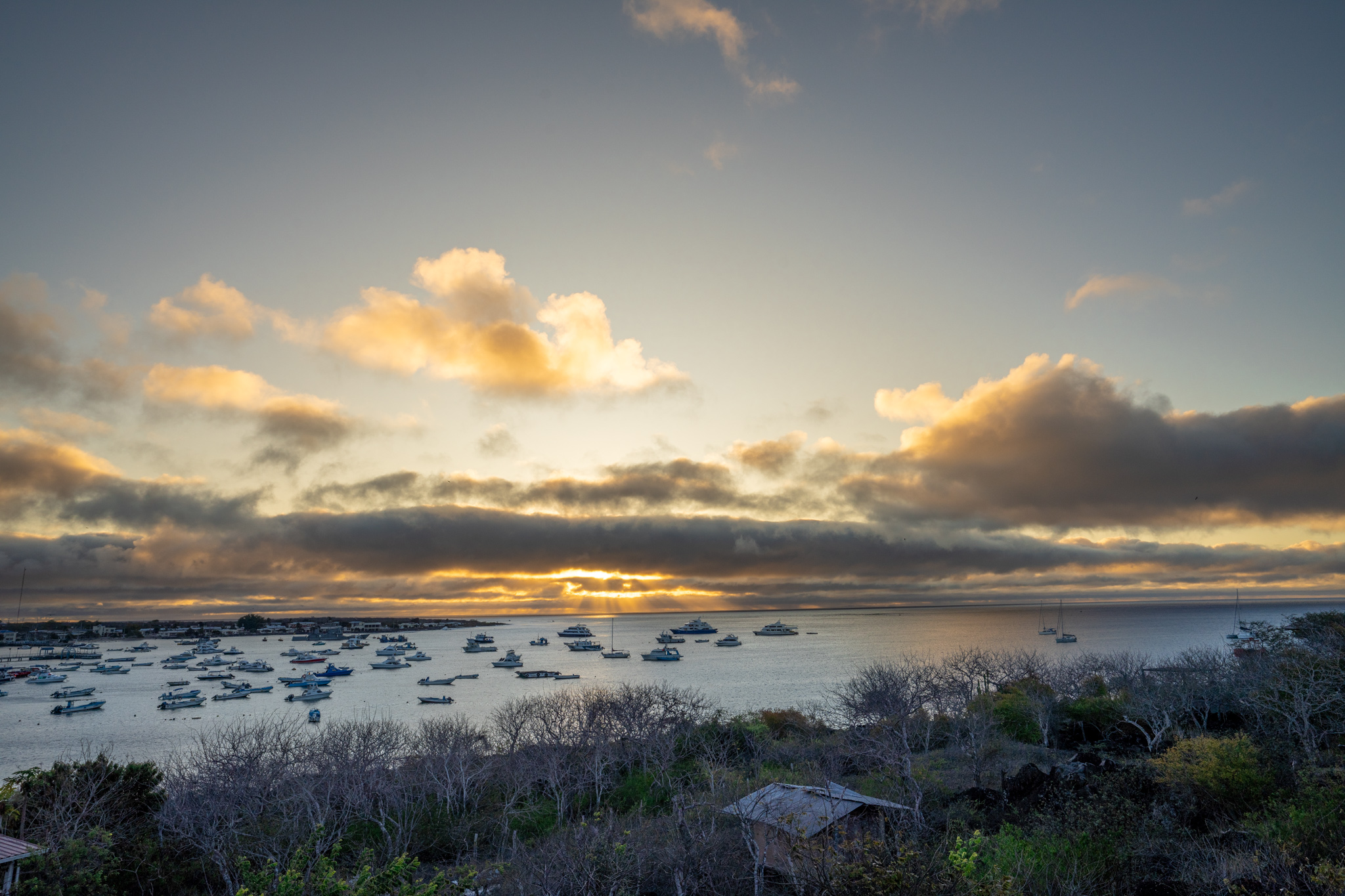
Watching the sun setting over San Cristóbal island
Each island in the Galápagos is a unique and special place. And to be able to go there is a unique and special experience. I could employ the oft-used phrase ‘once in a lifetime experience’ except that I hope it wasn’t. We would like to return one day, to see other islands, to find that conservation remains paramount, and perhaps to discover that some of those areas and species that remain concealed from tourism today have recovered so well that they are revealed.
